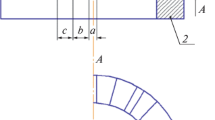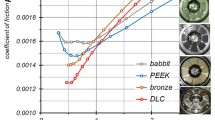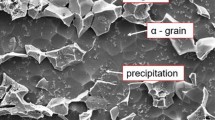Abstract
This paper is devoted to model tribological experiments and analysis of the research results obtained for new materials and coatings, such as SiSiC, with the aim to rank them and to make recommendations for use in thrust hydrodynamic friction units operating at high speeds and loads.
Similar content being viewed by others
When operating under extreme conditions, the performance of new equipment is provided by the design features of friction surfaces and the use of new promising materials. Operation conditions that can be classified as extreme arise in large friction units operating at high sliding speeds and loads.
A distinctive feature of the operation conditions of circulation pumps is their continuous and reliable operation for a long time estimated in tens of thousands of hours, without repair or direct maintenance. One of the most important and, in most cases, determining in the performance of pumps are the radial and axial sliding bearings and mechanical seals, for which the pumped medium, mainly distilled water, as well as petroleum oils, etc., is used as a lubricant and coolant.
Sliding bearing materials can be metallic or nonmetallic. Metal ones are divided into ductile (<HB 50), soft (HB 50–100), and hard (>HB 100) bearing alloys. Plastic materials include babbitts, lead bronzes, aluminum alloys, and silver; tin, tin–lead, and tin–lead–zinc bronzes belong to soft materials; hard ones are aluminum–iron bronze and cast iron.
Nonmetallic materials are used for plain bearings. Plastics, hardwood, reinforced wood, rubber, and graphite are used as materials for the bearings. All of the materials listed are used in combination with shafts with increased hardness (>HRC 50). Under this condition, nonmetallic bearings exhibit high wear resistance.
A distinctive feature of nonmetallic bearing materials is low thermal conductivity. Almost all of them work better in water than in oil.
The use of water lubrication is justified in cases where the machine operates with water (water pumps) or in water (propeller installations, underwater power tools, etc.). In some cases, water lubrication is also used for general purpose machines. With water lubrication, the shafts are made of hardenable corrosion-resistant steels (30Kh13, 40Kh13 types). The metal bearing housings should be protected from corrosion.
For highly loaded high-speed bearings designed to operate in liquid lubrication, plastic alloys are used almost exclusively in the form of thin layers applied to steel (less often bronze) bushings and liners [1].
Soft and hard alloys are used for manufacturing boundary and mixed-film lubricated bearings that operate at moderate speeds.
It is known from the literature [2–4] that sliding silicon carbide bearings are characterized by very high thermal resistance with extremely low thermal expansion as well as the highest hardness. Therefore, friction and wear are very low or practically absent when hydrodynamic lubrication occurs. This is why these materials are also suitable for working in difficult conditions. However, there is no information on the performance of these bearings at high speeds.
SiSiC ceramic is also called reaction bonded sintered silicon carbide ceramic; it is a high-grade ceramic material with excellent abrasion resistance and high temperature resistance, and it also has the advantage of corrosion resistance to various chemicals. SiSiC ceramics can be used as wear-resistant material in the mining industry, power plants, steel mills, etc. Also, this material can be used as a refractory material in the ceramic industry, metallurgical industry, etc. Thanks to the excellent technology and cutting-edge equipment, Duratec SiSiC ceramics enjoy an excellent reputation in the market.
The advantages of SiSiC ceramics are the following: (1) excellent wear resistance, impact resistance, and corrosion resistance; (2) excellent flatness and excellent heat resistance up to 1350°C; (3) ease of installation; (4) longer service life (about five times longer than that for alumina ceramics and six times longer than for polyurethane).
The tribological tests were carried out using the MIS-01 test bench (Fig. 1) designed for testing the axial supports of the seal section of high-speed vane pumps [5]. The tests included an estimate of the time to reach the hydrodynamic mode and the friction coefficient.
The test modes are as follows: (1) rotation speed of 1000, 3000, 6000, and 10 000 rpm; load of 200, 500, 1000, 1500, 2000 N; (2) test time is ten minutes at each loading stage; (3) medium is Tp22 turbine oil (the desired lubrication system for the tribocouple is circulation with oil cooling).
Based on the design documentation containing the dimensions and operating conditions of the thrust bearings of the main VVER 1000 circulation pumps, the testing technique for a prototype of thrust bearings was developed. The technique is based on the use of conditions for loading experimental samples with the modes calculated from the condition that the load-bearing capacity of the model tribocoupling is equal to the load capacity of a thrust bearing of the VVER 1000 main circulation pump, which is determined by the product pV.
Based on the literature data [6–8], which indicate the magnitude of loading of the tribological interfaces of the thrust bearings of the main circulation pumps, a technique to determine experimentally the performance according to the criterion of the load-bearing capacity of the test samples has been developed.
The main stages of the tests are the following: (1) Determination of the static friction of tribocoupling that occurs when starting off and moving at low speed. In this case, the limit torque of the thrust bearing drive shaft is determined. (2) Tests are carried out with a dry friction chamber and in a friction chamber filled with working fluid (technical water and oil). (3) Tests are carried out in the dynamic mode to identify the whole range of tribological interface performance, as a result of which the limiting load-bearing capacity pV is determined.
Experimental tribological studies of test samples of new materials and coatings using a test bench. The pair of the heel sample and the foot bearing made of SiC + SiC silicon carbide is shown in Fig. 2.
Experimental results. A diagram of the static friction of the test sample of SiSiC heel + SiSiC foot bearing is shown in Fig. 3. Table 1
The test reports for SiC + SiC tribocoupling in the water and Tp22 turbine oil working media are listed in Tables 2 and 3, respectively.
A tribogram of the dependence of the sliding friction speed on the friction coefficient and on the load-bearing capacity of the pair SiSiC + SiSiC in different media is shown in Fig. 4.
CONCLUSIONS
The experimental results have shown that the most promising materials for use in thrust bearings of VVER main circulation pumps at high speeds are tribocoupling materials of SiSiC with respect to SiSiC (SiSiC heel + SiSiC thrust bearing sample). The use of these friction pairs can be an effective means to reduce friction forces at high speeds (speeds up to 10 000 rpm).
REFERENCES
Chichinadze, A.V., Braun, E.D., Bushe, N.A., et al., Osnovy tribologii (trenie, iznos, smazka) (Foundations of Tribology: Friction, Wear, and Lubrication), Chichinadze, A.V., Ed., Moscow: Mashinostroenie, 2001.
Qiu, Y. and Khonsari, M.M., Investigation of tribological behaviors of annular rings with spiral groove, Tribol. Int., 2011, vol. 44, no. 12, pp. 1610–1619. https://doi.org/10.1016/j.triboint.2011.05.008
Suh, M.-S., Chae, Yo.-H., Kim, S.-S., Hinoki, T., and Kohyama, A., Effect of geometrical parameters in micro-grooved crosshatch pattern under lubricated sliding friction, Tribol. Int., 2008, vol. 43, no. 8, pp. 1508–1517. https://doi.org/10.1016/j.triboint.2010.02.012
Gavrilko, A.I., Enhancing the reliability of power supply of main industrial consumers of ultrahigh-power nuclear power plant power units, Elektro. Elektrotekh., Elektroenergetika, Elektrotekhnicheskaya Prom-st., 2009, no. 1, pp. 26–30.
Cheremisinov, E.M. and Splavskiy, I.S., Testing procedure for the tribological properties of axial bearings, J. Mach. Manuf. Reliab., 2023, vol. 52, no. 3, pp. 281–285. https://doi.org/10.3103/S1052618823020024
Yushin, E.S., Nasosnoe oborudovanie sistemy truboprovodnogo transporta nefti i nefteproduktov (Pump Equipment of Oil and Oil Products Pipeline Transport System), Ukhta: Ukhtinskii Gosudarstvennyi Tekhnicheskii Universitet, 2019.
Vetokhin, V.I., Submerged induction electric motor of open design of new generation of type AMV NGS for oil and gas wellbores, Morskoi Vestn., 2011, no. 3, p. 51.
Konovalov, A.S., Kopanskii, A.S., Kultyshev, V.V., and Utkin, A.S., Calculation of measurement-testing setup for the main circulation pump of a nuclear power plant, Metrologicheskoe obespechenie innovatsionnykh tekhnologii, Mezhdunarodnyi forum: Tezisy (Metrological Support of Innovation Technologies: Int. Forum, Proc.), St. Petersburg: S.-Peterb. Gos. Univ. Aerokosm. Priborostr., 2019, pp. 211–213.
Funding
This work was supported by ongoing institutional funding. No additional grants to carry out or direct this particular research were obtained.
Author information
Authors and Affiliations
Corresponding author
Ethics declarations
The authors declare that they have no conflicts of interest.
Additional information
Translated by M. Astov
Publisher’s Note.
Pleiades Publishing remains neutral with regard to jurisdictional claims in published maps and institutional affiliations.
Rights and permissions
This article is published under an open access license. Please check the 'Copyright Information' section either on this page or in the PDF for details of this license and what re-use is permitted. If your intended use exceeds what is permitted by the license or if you are unable to locate the licence and re-use information, please contact the Rights and Permissions team.
About this article
Cite this article
Erofeev, M.N., Splavskiy, I.S. The Technique of Tribological Studies of SiSiC High-Speed Thrust Bearings. J. Mach. Manuf. Reliab. 52, 607–612 (2023). https://doi.org/10.1134/S1052618823060067
Received:
Revised:
Accepted:
Published:
Issue Date:
DOI: https://doi.org/10.1134/S1052618823060067









 ; 2, oil
; 2, oil  ; 3, pV
; 3, pV  .
.